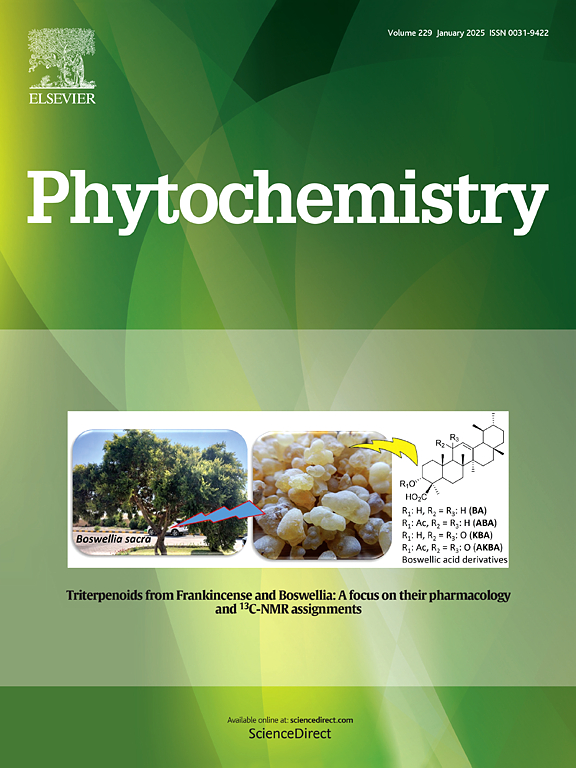青蒿素二聚体A-G,描述了从豆花蒿中提取的瓜蓝烷型倍半萜二聚体及其抗肝癌活性。
IF 3.2
2区 生物学
Q2 BIOCHEMISTRY & MOLECULAR BIOLOGY
引用次数: 0
摘要
从紫花蒿(Asteraceae)中分离到青蒿素二聚体A-G(1-7)、7个未被描述的瓜蓝烷型倍半萜二聚体(gsd)和27个已知化合物(8-34)。通过紫外、红外、质谱、核磁共振数据的综合分析,利用DP4+概率分析进行量子化学核磁共振计算,确定了它们的结构和相对构型,并用ECD计算确定了它们的绝对构型。所描述的GSDs(1-7)可能是通过Diels-Alder反应形成的,化合物5-7是罕见的具有H-6' α-构型的GSDs。化合物4 ~ 7对HepG2、Huh7和SK-Hep-1细胞有明显的抑制作用,IC50值在6.9 ~ 13.0 μM之间。通过网络药理学分析推断出最佳活性化合物5为p53信号通路蛋白AURKA,通过分子对接发现AURKA具有较高的结合亲和力(总分为-8.98),表面等离子体共振测定KD值为62.4 μM。本文章由计算机程序翻译,如有差异,请以英文原文为准。

Artemyriantholidimers A-G, undescribed guaiane-type sesquiterpenoid dimers from Artemisia myriantha and their antihepatoma activities
Artemyriantholidimers A-G (1–7), seven undescribed guaiane-type sesquiterpenoid dimers (GSDs), and 27 known compounds (8–34) were isolated from Artemisia myriantha (Asteraceae). Their structures and relative configurations were elucidated based on the comprehensive analyses of UV, IR, MS, NMR data, quantum chemical NMR calculations with DP4+ probability analyses, and the absolute configurations were elucidated by ECD calculations. The undescribed GSDs (1–7) were presumably formed via Diels-Alder reactions, and compounds 5–7 were rare GSDs with α-configuration of H-6'. Compounds 4–7 showed significant inhibition on HepG2, Huh7, and SK-Hep-1 cells with IC50 values ranging from 6.9 to 13.0 μM by antihepatoma assay. The best active compound 5 was deduced to be targeted on the protein AURKA of the p53 signaling pathway by network pharmacological analysis with a high bind affinity of AURKA (total score: −8.98) by molecular docking, and had a KD value of 62.4 μM by surface plasmon resonance assay.
求助全文
通过发布文献求助,成功后即可免费获取论文全文。
去求助
来源期刊

Phytochemistry
生物-植物科学
CiteScore
6.40
自引率
7.90%
发文量
443
审稿时长
39 days
期刊介绍:
Phytochemistry is a leading international journal publishing studies of plant chemistry, biochemistry, molecular biology and genetics, structure and bioactivities of phytochemicals, including ''-omics'' and bioinformatics/computational biology approaches. Phytochemistry is a primary source for papers dealing with phytochemicals, especially reports concerning their biosynthesis, regulation, and biological properties both in planta and as bioactive principles. Articles are published online as soon as possible as Articles-in-Press and in 12 volumes per year. Occasional topic-focussed special issues are published composed of papers from invited authors.
 求助内容:
求助内容: 应助结果提醒方式:
应助结果提醒方式:


